
 Circa 70 vessels including seven sloops, Green Water Navy.
Circa 70 vessels including seven sloops, Green Water Navy.
The Royal Indian Navy was one of the most modest fleets in the commonwealth, still superior to the South African navy, both in terms of size and scope, but on par with the RNZN and certainly lightyears of the Australian and Canadian fleets. In 1943 the RIN managed to be 20,000 personal strong, it started the war with eight warships, but grew to 53 “major”* warships and many more auxiliaries. *Nothing beyond a frigate. It played its part during WW2, mostly in home waters, but also the far east, although two sloops participated in Operation Husky, the Allied invasion of Sicily.
A Navy born in 1612
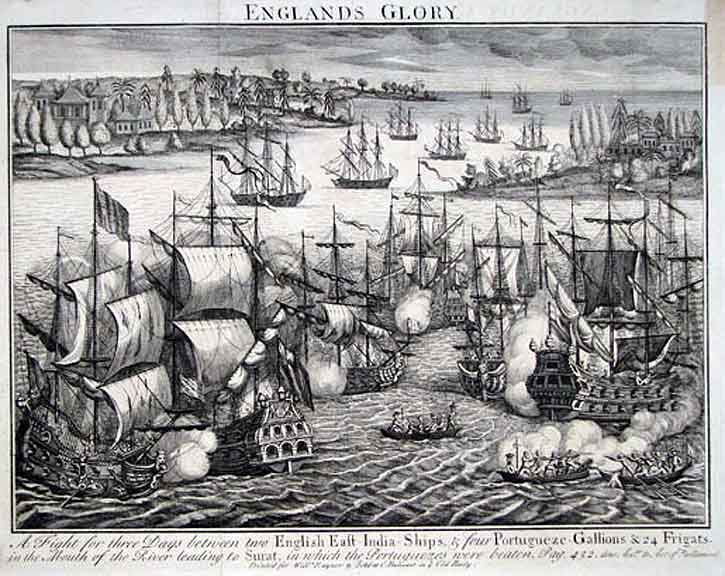
Few constituted Navies can trace their origin as far back as 1612. The Royal Navy itself was born in 1546, and the French Navy in 1624, so actually twelve years later. But this was hardly a fleet with native Indian crews: At that time it was called the East India Company, and basically it was a private commercial navy (created 1599). This change in 1612 as a local branch was created, permanently anchored in India, which illustrated itself when Captain Thomas Best defeated the Portuguese at the Battle of Swally that same year. Because of this, the motley fleet was called the ‘Honourable East India Company’s Marine’.
Its ships escorted merchant shipping off the Gulf of Cambay, on rivers and as far as Arabia and Persia. The core consisted in the late 17th century of a few vessels, probably Indiamans or bricks, and a large fleet of locally built gunboats. By 1635, a shipyard was established at Surat, allowing the construction of four fast pinnaces for the fleet and supply, cargo ships.
Two types were identified:
The large ghurabs (“grab”): Shallow-draft gunboats, three-masted, European style, 300 tons and armed with six 9/12-pdr guns
The small gallivats: 70 tons, six 2/4-pdr. These were riverine and coastal traditional vessels, wooden with lateen sails, and crewed by locals of the Malabar coast.
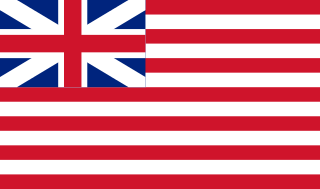 This fleet had many Indian sailors but led by British officers, and participated in the war against the Marathas and the Sidis, and the Anglo-Burmese Wars. The force was renamed in 1686, the “Bombay Marine” as it was localized there. By 1755 under Commodore William James, it had a 1st rank ship called the Protector, in which he attacked Maratha fortresses. With Robert Clive and Admiral Watson, the fleet also fought the French ambitions in the area, a conflict that was finally settled during the seven years war. From 1809, the fleet attacked pirates and secured trade between Asia and India. In 1829, this force was renamed the Bombay Marine Corps. It received soon its first armed paddle steamer, HCS Hugh Lindsay (411 tons). In 1830 it was officially renamed again the “Indian Navy” and participated in the second Burmese war and the Siege of Multan (Anglo-Sikh War). There was a joint expedition with the Royal Navy for the captured of capture of Martaban and Rangoon. Until 1854 one of the task of this fleet was also the mail service with Suez (next it was overland).
This fleet had many Indian sailors but led by British officers, and participated in the war against the Marathas and the Sidis, and the Anglo-Burmese Wars. The force was renamed in 1686, the “Bombay Marine” as it was localized there. By 1755 under Commodore William James, it had a 1st rank ship called the Protector, in which he attacked Maratha fortresses. With Robert Clive and Admiral Watson, the fleet also fought the French ambitions in the area, a conflict that was finally settled during the seven years war. From 1809, the fleet attacked pirates and secured trade between Asia and India. In 1829, this force was renamed the Bombay Marine Corps. It received soon its first armed paddle steamer, HCS Hugh Lindsay (411 tons). In 1830 it was officially renamed again the “Indian Navy” and participated in the second Burmese war and the Siege of Multan (Anglo-Sikh War). There was a joint expedition with the Royal Navy for the captured of capture of Martaban and Rangoon. Until 1854 one of the task of this fleet was also the mail service with Suez (next it was overland).
The 1857 rebellion put an end to the company rule in India, making way to direct rule. From then on the Navy became Her Majesty’s Indian Navy, in which the “bombay navy” was aggregated in 1877. The latter became the western division, whereas the eastern division was based at Calcutta. In 1892, the fleet became the Royal Indian Marine, and numbered over 50 ships. In 1905 this motley force was tasked to carry troops, survey, police and revenue duties.
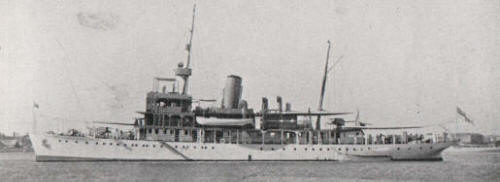
HMIS Lawrence in 1932
During WWI, the fleet became more active and was reinforced with a fleet of minesweepers. Indeed, German ships fleeing the Japanese from Tsingtao (admiral Graf Spee’s east asia squadron) made a diversionary coup by sending westwards SMS Emden. Mines were also detected off the coasts of Bombay and Aden. The RIM tasks were troops and supplies transport, from India to Mesopotamia, Egypt and East Africa, and patrol. The fleet operated the sloops CORNWALLIS and ELPHINSTONE from 1917. Bth ship were sent back to RN in 1922. In 1919 was aqcuired the Beardmore, Dalmuir buuilt HMIS Lawrence a 1200 tonnes sloop. She was active during WW2 as well. The sloop HMIS Clive, similar, was acquired in 1920 and also active in WW2. Both were disposed of in 1947. Two decoy patrol boats were also used in 1917, Baluchi and Patha, transferred to the RIN in 1922 and active in WW2. The latter was sunk by an Italian submarine in 1940.
The interwar:
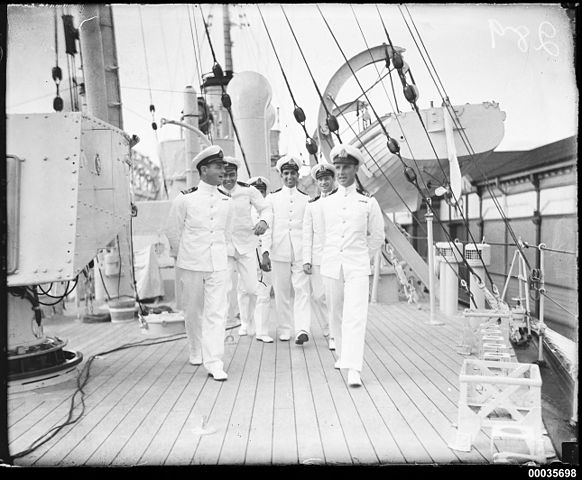
Royal Indian Navy officers on deck of HMIS HINDUSTAN, Sydney 1934
From 1928 to 1934, the RIM was commanded by Flag Officer Commanding and Director, vice admiral Sir Humphrey T. Walwyn. He was present during the 1934 reform as well.
In 1934 the Royal Indian Marine under the Act of 1934 was renamed as The Royal Indian Navy (RIN), formally inaugurated on 2 October 1934 at Bombay. From now on, its ships would bear the prefix HMIS (His/Her Majesty’s Indian Ship). But it stayed small. From November 1934, the RIN was placed under supervision of Vice-Admiral Arthur Bedford. In November 1937, Vice-Admiral
Sir Herbert Fitzherbert took command, and stayed so until 1943.
The RIN in WW2:
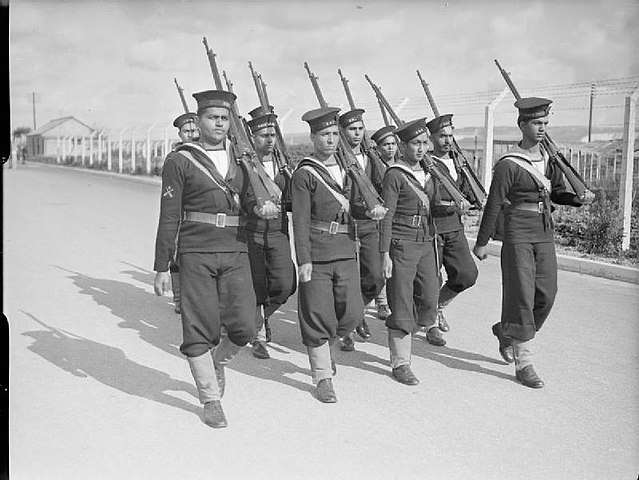
In 1939, this was still a small force, with just eight warships. But due to the situation in Asia dramatically evolving, and implication of India in the north African and Mediterranean campaigns, plus the global U-boat activity worldwide, India was at war well before December 1941. After Asia was at war globally, further efforts were made to acquire new assets, and the expansion of the RIN in ships and personnel was described by an author as “phenomenal”.
In 1943 the RIN’s navy personal numbered twenty thousand, and the Women’s Royal Indian Naval Service was created, for land-based personal.
The sloops HMIS Sutlej and HMIS Jumna were present during Operation Husky, the Allied invasion of Sicily, covering the landings.
From 19 March 1943, due to the scale reached by the RIN, it was commanded by Admiral John Henry Godfrey, until 1946.
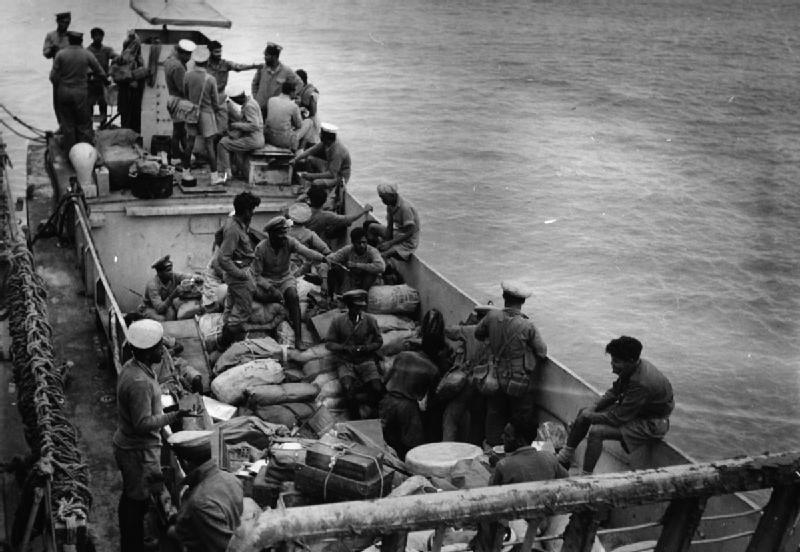
Commonwealth forces in Burma 1944-45, Indian troops and an Indian landing craft
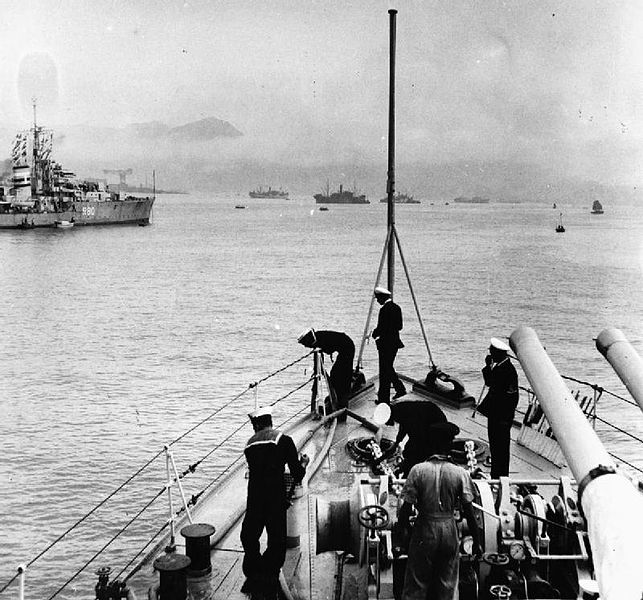
HMIS SUTLEJ leaves HongKong for Japan’s Occupation force in 1945
Post war years: Mutiny, Partition and cold war
The Mutiny of 1946
The Mutiny of 1946 started in February 1946, amidst movements launched since years by the Mahatma Gandhi (as a figurehead) and independence movements centered across the Indian Congress and Muslim League. Indian sailors (ratings mostly as many officers were still British) launched a massive Mutiny on board more than fifty ships and shore establishments. They collectively protested about alleged discrimination against Indian sailors and officers during the war. This mutiny found widespread support, relayed also in the Army and the Air Force. In the end, a total of seventy-eight ships, and 20,000 sailors were implicated. At the time, there was still a lot to do, between troops to repatriate and Japanese garrison to disarm and send in various POWs, so the mutiny had quite an effect on the Royal Navy operational schedules in the region. The mutiny was helped by the fact it grew ten times, and recruitment was no longer reserved to some groups, with loyalty was easier to obtain, but throughout India.
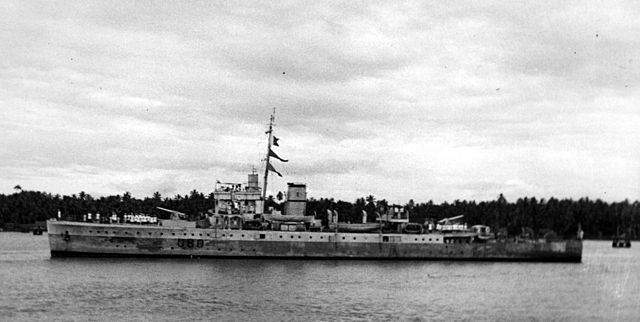
The confrontation saw a lot of arrests (added to the 11,000 RIN prisoners already) and reached a peak when Royal Artillery C. Troop arrived on the island facing the INS destroyer Hindustan and after an ultimatum came without answer, fire broke up, between the battery and the ship. However after a while, the white flag was hoisted to evacuate injured personal and put an end to the duel. However, these acts of violence were condemned by Gandhi and leaders of the independence movements, and the lack of support ended the revolt. In fact, only the Communist Party of India, the third largest political force at the time fully supported the mutineers, making it even suspicious to British authorities. Also, it ended because of its poor leadership, tensions between officers which had mostly loyalist allegiances. However, fearing a 1857-style all army branches mutiny with post-WW2 millions Indians at arms, the British were further convinced to leave India.
Independence and Partition
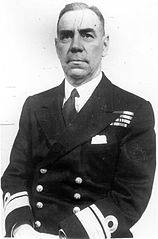 On 1 March 1947, the designation “Flag Officer Commanding, Royal Indian Navy” was replaced by “Commander-in-Chief”. India’s independence was followed by a partition, but the Royal Indian Navy was divided between the newly independent Dominion of India and the Dominion of Pakistan, and the Armed Forces Reconstitution Committee divided the ships and men of the Royal Indian Navy between the newly created states of India and Pakistan. The fleet was divided eventually, based on their current bases orf the West and East, and on a basis of two-thirds for India, one third for Pakistan. On 21 July 1947, the officers Choudhry and Bhaskar Sadashiv Soman became captains, the first in the RIN, and would eventually command the Pakistani and Indian Navies respectively.
On 1 March 1947, the designation “Flag Officer Commanding, Royal Indian Navy” was replaced by “Commander-in-Chief”. India’s independence was followed by a partition, but the Royal Indian Navy was divided between the newly independent Dominion of India and the Dominion of Pakistan, and the Armed Forces Reconstitution Committee divided the ships and men of the Royal Indian Navy between the newly created states of India and Pakistan. The fleet was divided eventually, based on their current bases orf the West and East, and on a basis of two-thirds for India, one third for Pakistan. On 21 July 1947, the officers Choudhry and Bhaskar Sadashiv Soman became captains, the first in the RIN, and would eventually command the Pakistani and Indian Navies respectively.
Admiral John Henry Godfrey was replaced in 1946 by Vice-Admiral Sir Geoffrey Audley Miles, now “Commander-in-Chief, Royal Indian Navy”, until replaced by Rear Admiral John Talbot Savignac Hall in this role, as “chief of naval staff” in 1948 (new additional designation from 21 June 1948)). With the partition of India, the last commander of the RIN (partitioned and named the Pakistani and Indian navies) was Vice Admiral Sir William Edward Parry, which left office 25 January 1950. From then on, the supreme head of both new navies and the naval staff were to be all Indians or Pakistani, as the divide was effective after a two years transition period.
In detail, the joint committee that decided the allocation gave to the Royal Pakistan Navy (RPN) three sloops HMIS Godavari, HMIS Hindustan and HMIS Narbada, four minesweepers, two frigates, two naval trawlers, four harbour launches and some extra Harbour Defence Motor Launches. 358 Muslim or European personnel including 180 officers volunteered to serve wit the RPN. The Indian Navy retained the remainder, most British officers volunteering to continue their service with the RIN. The additional designation of “Chief of the Naval Staff” underline the transitional role of the last vice admiral, Sir William Edward Parry which stayed from 1948 to 1950 to organize the full transfer to a purely Indian naval staff.
From 26 January 1950 India adopted a Republican constitution, as a republic, and “Royal” was removed as a title for what became until now, the Indian Navy. The white ensign’s Union Jack was replaced with the Flag of India as well. Ship designation also changed from “HMIS” to the ‘INS’ prefix.
Cold War years: The Republican Indian Navy
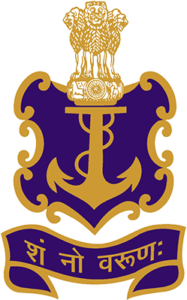 It’s not the subject (yet), but let’s have a look on the IN timeline in the 1950-60s:
It’s not the subject (yet), but let’s have a look on the IN timeline in the 1950-60s:
-In 1947, the fleet counted the modified Bittern class Frigates (ex sloop) Jumna, Sutlej, the Black Swan class Cauvery, Tir, and Kistna and Khukri, and the ex-Bangor class Rohilkand, Konkan, Rajputana, and the ex-Bathurst class Bengal, Bombay and Madras. They were disposed of in the 1960s, the Frigates in 1979-83.
-The main acquisition was in July 1948, the IN Delhi (C74). She was the ex-Achilles, Leander class cruiser, arriving in India in September, refitted. In 1953 she played herself in the movie “battle of the river plate” and in 1961, assisted Indian troops when seizing Goa from the Portuguese. Still active in 1971, she has been replaced by IN Mysore as flagship since 1957, made a last good will tour in 1969 and became a TS in Cochin, until disposed of in 1978, the last interwar British cruiser in existence (with the more recent hms Belfast in London).
-In July-September 1949, three wartime “R” class destroyers were acquired, they served until 1976-79, when replaced by five more modern Soviet-built Kashin II missile destroyers (The Rajput class), and in the 1990s the first domestic designed Delhi class.
-In 1953, three new “Hunt” class frigates were purchased, IN Ganga, Godavari and Gomati, and in 1955-57, the Blackwood class Khukri, Kirpan and Kuthar. All these ships were disposed of in the 1970s.
-In 1957 another cruiser was purchased, the more modern Crown colony class Nigeria, rebaptised upon arrival IN Mysore, becoming the new de facto flagship of the Navy. She was discarded and BU in 1986. The same year were also purchased the first modern ASW Frigates of India, the rothesay class Talwar and Trishul, and the Leopard class Brahmaputra, Beas and Betwa. All these were discarded in the 1990s.
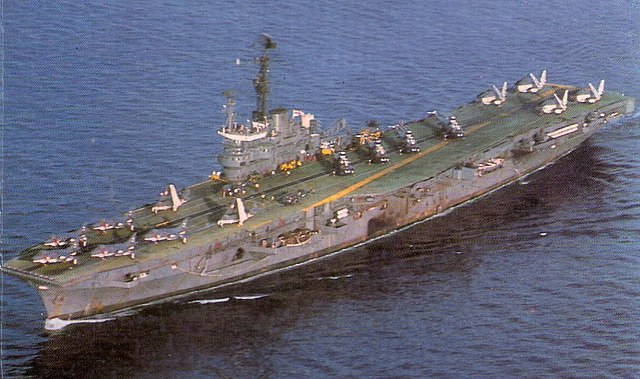
INS Vikrant, first Indian aicraft carrier
-Aircraft Carriers: In 1961, a bold step was taken with the acquisition of the first Indian aircraft carrier, the ww2 Majestic class ex-HMS Hercules, modernized as INS Vikrant. She stayed active until replacement by the first Indian domestic CV, also named INS Vikrant. The original ship was scrapped in 2014, while a second carrier was acquired in 1986, the Viraat, ex HMS Hermes, veteran of the Falklands. Also in 2013, India acquired the Vikramaditya, ex Kiev-class Admiral Gorshskov, completely rebuilt and modernized as a smaller version of the Kuznetsov class carrier.
-Modern Frigates: In 1966-75 were built, for the first time in India, at Mazagon docks of Bombay, six ASW Frigates, based on the British “broad beam Leander” class. In 1980, three fully Indian design Godavari class frigates and in the 1990s, three new improved Frigates of the type.
-Indian Submarines: There were none in service, even a WW2 model, until the purchase of eight Foxtrot class from USSR in 1968-74, discarded in the 1990s as the first modern German-design SSKs were obtained in the 1980s, the Shishumar class, eight Kilo type SSks from USSR as well as a unique Charlie I SSGN type, INS Chakra. More recently was developed the first local SSBN class, the Arihant.
-Indian Amphibious ships: An ex-British LST3 was acquired in 1951 (INS Magar), Ten soviet-built Polocny class LS in the 1960s, and locally built three LCU (Vasco de Gama class) in 1980 plus the to wo Magar-class based on the Sir Lancelot class TLS.
-Corvettes 12 Petya III class corvettes were acquired in 1969-74, 3 nanuchka II, 10 Tarantul I class, and six Indian-built Khukri class missile corvettes from 1989, followed by the 1990s Abhay class ASW corvettes.
-Smaller vessels: 16 Osa class FACs, 5 SBD Mk2 class PCs, 4 “Ford” class SDB, 5 Poluchat class CPC, 7 Sukanya class OPVs, 9 Vikram class OPBs, 4 “Ton class”, 3 Ham class, 12 Natya class and 6 Yevgenya class minesweepers.
This subject of course will be reviewed in great detailed in a cold war dedicated post.
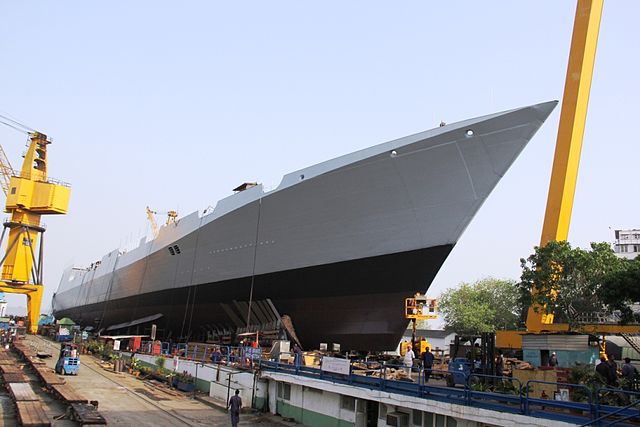
Launching of INS Visakhapatnam in 2015, lead ship of a class of four 7500 tonnes missile destroyers
Read More
//uboat.net/allies/warships/navy/HMIS.html
//www.naval-history.net/xDKWD-EF1942b.htm (eastern fleet diary)
//en.wikipedia.org/wiki/Royal_Indian_Navy
//www.indiannavy.nic.in/
//www.naval-history.net/WW2CampaignsIndianOcean.htm#hoko
//dutcheastindies.webs.com/ondina.html
Nomenclature of the RIN in WW2
 Tir Class Frigates
Tir Class Frigates
HMIS Tir, Khukri, Shamsher, Dhanush
These River class Frigates were acquired from December 1945, so they had no service in WW2.
 Sutlej Class Sloops
Sutlej Class Sloops
HMIS Sutlej, Jumna, Kistna, Cauvery, Narbada, Godavari, Hindustan

This six sloops had different origins: The first ones, commissioned during WW2, were of the Bittern class, later Black Swan class. They had quite an active service and formed the bulk of the RIN. Originally they had an AA escort role, with their three twin QF 4 in (102 mm) Mk XVI AA guns and four twin 2-pounder AA pom-pom, completed at first by four 0.5-inch (12.7 mm) AA machine guns. After Bombay’s refit, the ships were rearmed with a far more potent combination of 12 × 20 mm Oerlikon AA in twin mounts. For their displacement they packed a powerful AA punch, worthy of a cruiser.
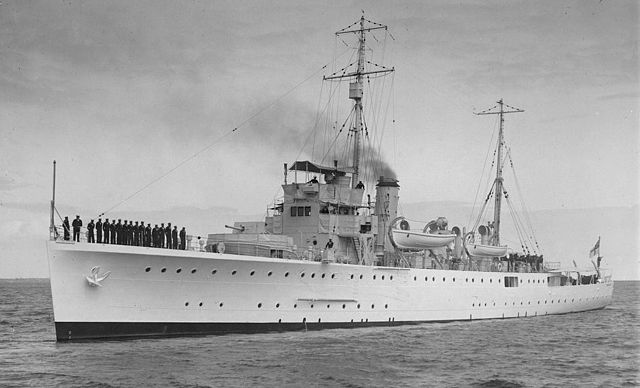
INS Hindustan (1930), was the first major warship in service with the RIN, not of the Bittern class but of the Hastings-class design, modified and lenghtened specifically for tropical service. She displaced 1,190 long tons (1,210 t) for 296 ft (90.2208 m) oa, a beam of 35 ft (10.67 m) and draught of 11 ft 6 in (3.51 m). With her 2 steam VTE she could reach 16 knots. Her armament comprised two 4 in (100 mm) QF Mk IV guns and four QF 3-pounder 47 mm (1.9 in) saluting guns. Needless to say it was entirely overhauled during WW2, put to standards. Her long wartime career comprised operations in the Persian Gulf, Straits of Hormuz and East Indies Station, eat africa campaign, and refitted in Mumbay she received a sonar and AA (40 mm pompom). She participated in Operation Dracula as well.
INS Sutlej of the Bittern class had one of the most emblematic career: She was commissioned on 23 April 1941. She was deployed for convoy defence in the Irish Sea, covering later the convoy WS11 through the Northwest approaches and escorted a part of the convoy to Freetown before heading for the Indian Ocean with Repulse, Encounter, Derbyshire and Woodruff, still in escort.
In September, she served in the Mediterranean, for AA defence in Suez, before heading back to the coast of Indian in December 1941. She escorted convoys to Singapore, up to Persian Gulf and Aden until early 1943, based in Alexandria ater for the same role, and Operation Husky in July. In September, she supported operations in the Aegean Islands and in December 1943, returned to convoy escort in the Arabian Sea and the Bay of Bengal. June 1944: She made ASW patrols in the Indian Ocean, was refitted in Bombay, and she supported landings in Burma and Malaya’s task forces, Operation Dracula (Rangoon) with most sloops of the RIN, and went on operating later, intercepting Japanese troops from the Andamans. She refitted in Bombay on V-Day and later went in Japan, carrying troops for the occupation.
INS Jamuna: (Black swan class, like the following) was awarded for her exceptional defense against Japanese air attacks, as she took part in the Java Sea campaign in February 1942, claiming at least five twin-engined level bombers and dive bombers. In 1945 she supported landing of the 74th Indian Brigade BIN on the Akyab Peninsula (Operation Lightning), and later was in Task Force 64 on Ramree.
INS Kistna: made at first convoy escort duties between the UK and West Africa and repelled Wolfpack Schill, being later transferred to the Eastern Fleet, escorting convoys to Bombay, the Persian Gulf, the Bay of Bengal and Indian Ocean, supporting 1944-45 landing operations of the BIA and British Army in Burma: Operation Romulus, Ramree, Operation Dracula, Operation Collie, Operation Zipper.
HmIS Cauvery:: Convoy escort in the Bay of Bengal, Indian Ocean, Operation Dragoon, TF66 (ASW patrols), bombardment of Letpan and Operation Turret, Dracula, Collie and Zipper.
HMIS Narbada: About the same career.
HMIS Godavari: Started service in June 1943, served on the UK-Gibraltar route, Eastern Fleet in 1944 shere she sank German submarine U-198 near the Seychelles and she supported in 1945 like the others all military operations in Burma.
HMIS Hindustan:
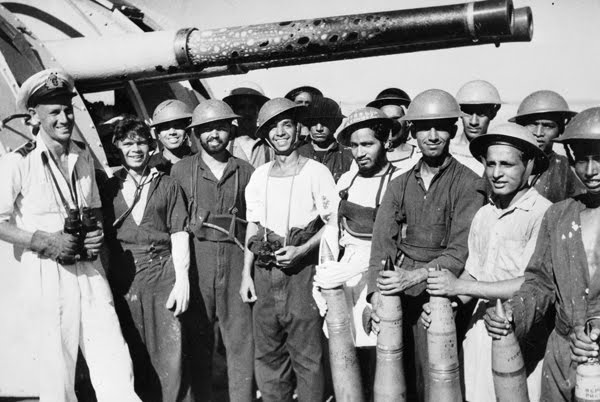
Crew of HMIS Narbada with blistered gun barrels following the bombardment of Myebon, Hunters Bay, Burma
Specifications (1943 ships): As Black Swan class
Displacement: 1,250 tons/ 1,350 tons FL
Dimensions: (91.29 x 11.43/11.73, 3.4 m)
Propulsion: Geared turbines on 2 shafts, 3,600 hp/4,300 hp
Speed: 19/20 knots after refit, Range: 7,500 nm/12 knots
Armament: 6 × 4 in (102 mm) Mk XVI, 4 × 2-pdr AA, 6×2 × 20 mm Oerlikon AA
Crew: 180-192 (modified)
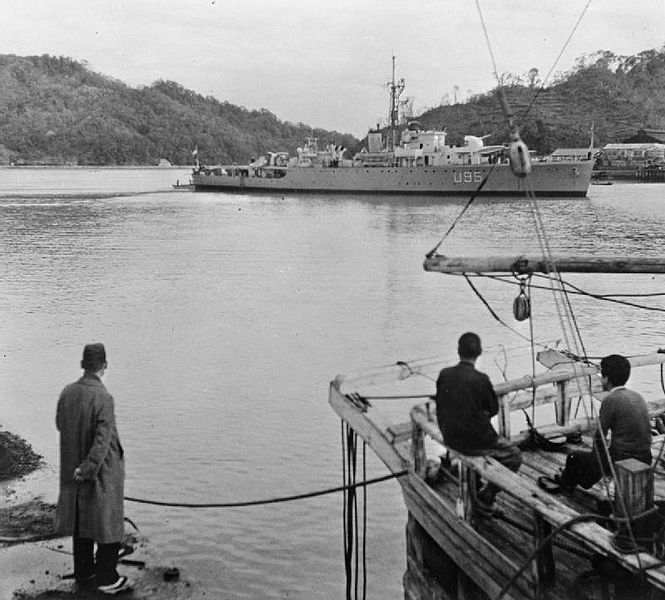
HMIS Sutlej at Kochi, Japan, 1946 (IWM).
 Assam class corvettes (1945)
Assam class corvettes (1945)
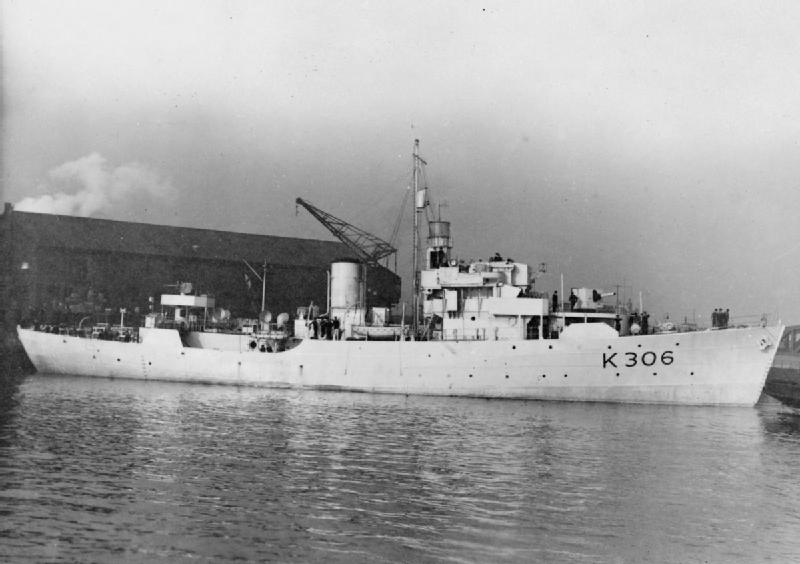
Sole Flower class Corvette in service with the RIN. However her construction draged on and was only transferred 1945. She was originally ordered for and commissioned as HMS Bugloss, transferred to the RIN immediately upon commissioning on 19 February 1945, and she served as Assam until 1947, back to the RN. She joined the Eastern Fleet just months before the end of the war, escorting convoys. There were three other corvettes, Sind, Gondwana and Mahratta trasferred in 1945-46.
 Orissa class Minesweepers
Orissa class Minesweepers
HMIS Orissa, Deccan, Bihar, Kumaon, Rohilkhand, Khyber, Carnatic, Rajputana, Konkan, Bombay, Bengal, Madras, Kathiawar, Baluchistan, Oudh, Malwa, Punjab.
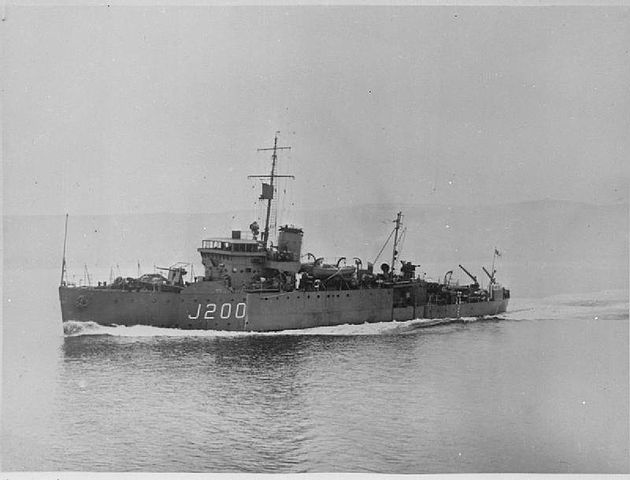
HMIS Orissa
These were Bangor and Bathurst class minesweepers, commissioned in 1942-43. Specifications are like those ships.
Although they were classed as minesweepers, they did most of their career convoy escort, mainly between the Indian Ocean and Mediterranean in the early phase of the war, and by 1945, in the far east and in support of the Burma-Malaya campaign or between Africa, British India and Australia, and in Japanese home waters for some.
HMIS Bombay was in service sooner, in early 1942 and she was present in Sydney Harbour during the Japanese submarine attack in May-June 1942. She escorted convoys between India and the Persian Gulf and in 1945 was present at Operation Dracula.
HMIS Bengal also had a long career. In November 1942, she was escorting the Dutch tanker Ondina southwest of Cocos Islands when attacked by two Japanese commerce raiders armed with six-inch guns. Bengal scored hits on Hōkoku Maru, blew up and sank, but both Ondina and Bengal ran out of ammunition and Ondina was badly damaged by shellfire and torpedoes but she did not sank while Bengal sailed away, not able to do anything. Meawnhile, Aikoku Maru, machine-gunned Ondina’s lifeboats and picked up the survivors from Hōkoku Maru before sailing off in turn. Both believed Ondina was sinking whereas the survivors reboarded her ship and managed to sail to Freemantle.
HMPS Kathiawar, Baluchistan, HMPS Oudh, HMPS Malwa, HMPS Punjab were all passed to the Pakistan Navy after the partition.
Video: The History Guy about the combat of HMIS Bengal
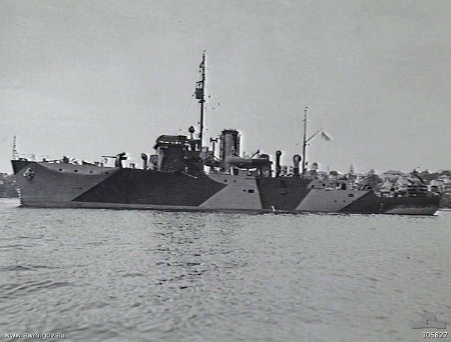
HMIS Bombay
Specifications:
Displacement: 800 or 1,025 tons FL, dimensions 186 ft (57 m)x 31 ft (9.4 m)x 8.5 ft (2.6 m)
Propulsion: TE engines on 2 shafts. 2,000 hp, speed 15 knots
Range: 2,800 nmi (5,200 km; 3,200 mi) at 10 knots (19 km/h; 12 mph)
One 12-pdr*, one 40 mm Bofors gun, 2-3 × 20 mm Oerlikon guns** and up to 40 depth charges, Type 128 asdic
*Or single 12-pounder 3-inch (76 mm) anti-aircraft gun
**Or quadruple Vickers .50 machine gun
Crew: 85
 Misc. vessels of the RIN
Misc. vessels of the RIN
Hira class gunboats
Hira, Lal, Moti and Nilam: ex-Iranian gunboats captured on 25/8/1941 during the joint Sovit-British Iran invasion. They were captured and transferred to the RIN, and served from Bombay as training an dpatrol vessels until sent back to Iran in 1946 (See the Iranian page for details).
Survey vessel HMIS Investigator
HMIS Investigator was a 1932 survey vessel of the Royal Indian Navy purchased in 1932. From 1947 she served with the new Indian Navy and was sold in 1951.
Armed Trawlers
HMIS Nasik, Calcutta, Cochin, Amritsar, Shillong, Rampur, Baroda. Also the auxiliary trawlers Laxmi (1918, 301 tonnes) and Nautilus (1913, 290 tonnes)
Motor minesweeper(MMS)
MMS 130, 132, 151, 154, 129, 131. In addition the RIN operated two auxiliary minesweepers: Satyavati (1911, 295 tonnes) and Tanjore (1941).
Motor Launches (ML380 class)
ML-380 and following, 28 ships in all, built for some in South Africa, and all the rest in Calcutta (Garden Reach and Burn NyD), Bombay, India general Navigation, H.mohatta in Karachi and Alcock Alsdown, same location. These successful multi-purpose model were used as minesweepers, minelayers and ASW patrol ships, base don the Fairmile B class, Wooden built with a round-bilge hull.
Harbour Defence Motor Launches (HDML)
HDML 1110, 1112, 1117, 1118, 1261, 1262, 1263, 1266. ML1087 was transferred in 1944. British built, as a harbour defence patrol launches.
Fleet Tanker: HMIS Chilka
Auxiliary ASW vessels:
During WW2, the RN operated merchant cruisers, such as Bhadravati (1932), Haideri (ex-German Julianpark, captured 1920), Irrawadi (1913), Kalavati (1928), Netravati (1909), Pangkor (1929), Sarvati (1927), Sonavati (1935), Sophie Marie (1923), and Victoria-Marie (ex-Africana, 1926), all around 1150-1600 tonnes, used as auxiliary patrol and anti-submarine vessels.
Armed Yachts:
Sea Belle (1927, built at White, Cowes, UK) 1057 tonnes, 71.0(pp) x 10.2 m, 2VTE and two 76mm/40 guns.

 Latest Facebook Entry -
Latest Facebook Entry -  X(Tweeter) Naval Encyclopedia's deck archive
X(Tweeter) Naval Encyclopedia's deck archive Instagram (@navalencyc)
Instagram (@navalencyc)





 French Navy
French Navy Royal Navy
Royal Navy Russian Navy
Russian Navy Armada Espanola
Armada Espanola Austrian Navy
Austrian Navy K.u.K. Kriegsmarine
K.u.K. Kriegsmarine Dansk Marine
Dansk Marine Nautiko Hellenon
Nautiko Hellenon Koninklije Marine 1870
Koninklije Marine 1870 Marinha do Brasil
Marinha do Brasil Osmanlı Donanması
Osmanlı Donanması Marina Do Peru
Marina Do Peru Marinha do Portugal
Marinha do Portugal Regia Marina 1870
Regia Marina 1870 Nihhon Kaigun 1870
Nihhon Kaigun 1870 Preußische Marine 1870
Preußische Marine 1870 Russkiy Flot 1870
Russkiy Flot 1870 Svenska marinen
Svenska marinen Søværnet
Søværnet Union Navy
Union Navy Confederate Navy
Confederate Navy Armada de Argentina
Armada de Argentina Imperial Chinese Navy
Imperial Chinese Navy Marinha do Portugal
Marinha do Portugal Mexico
Mexico Kaiserliche Marine
Kaiserliche Marine 1898 US Navy
1898 US Navy Sovietskiy Flot
Sovietskiy Flot Royal Canadian Navy
Royal Canadian Navy Royal Australian Navy
Royal Australian Navy RNZN Fleet
RNZN Fleet Chinese Navy 1937
Chinese Navy 1937 Kriegsmarine
Kriegsmarine Chilean Navy
Chilean Navy Danish Navy
Danish Navy Finnish Navy
Finnish Navy Hellenic Navy
Hellenic Navy Polish Navy
Polish Navy Romanian Navy
Romanian Navy Turkish Navy
Turkish Navy Royal Yugoslav Navy
Royal Yugoslav Navy Royal Thai Navy
Royal Thai Navy Minor Navies
Minor Navies Albania
Albania Austria
Austria Belgium
Belgium Columbia
Columbia Costa Rica
Costa Rica Cuba
Cuba Czechoslovakia
Czechoslovakia Dominican Republic
Dominican Republic Haiti
Haiti Hungary
Hungary Honduras
Honduras Estonia
Estonia Iceland
Iceland Eire
Eire Equador
Equador Iran
Iran Iraq
Iraq Latvia
Latvia Liberia
Liberia Lithuania
Lithuania Mandchukuo
Mandchukuo Morocco
Morocco Nicaragua
Nicaragua Persia
Persia San Salvador
San Salvador Sarawak
Sarawak Uruguay
Uruguay Venezuela
Venezuela Zanzibar
Zanzibar Warsaw Pact Navies
Warsaw Pact Navies Bulgaria
Bulgaria Hungary
Hungary

 Bundesmarine
Bundesmarine Dutch Navy
Dutch Navy Hellenic Navy
Hellenic Navy Marina Militare
Marina Militare Yugoslav Navy
Yugoslav Navy Chinese Navy
Chinese Navy Indian Navy
Indian Navy Indonesian Navy
Indonesian Navy JMSDF
JMSDF North Korean Navy
North Korean Navy Pakistani Navy
Pakistani Navy Philippines Navy
Philippines Navy ROKN
ROKN Rep. of Singapore Navy
Rep. of Singapore Navy Taiwanese Navy
Taiwanese Navy IDF Navy
IDF Navy Saudi Navy
Saudi Navy Royal New Zealand Navy
Royal New Zealand Navy Egyptian Navy
Egyptian Navy South African Navy
South African Navy






























 Ukrainian Navy
Ukrainian Navy dbodesign
dbodesign